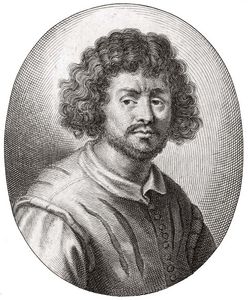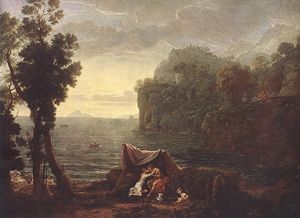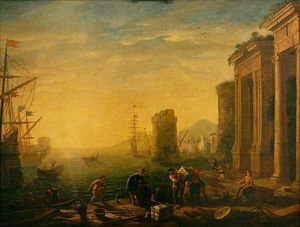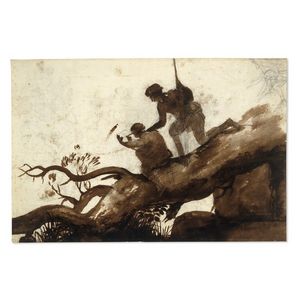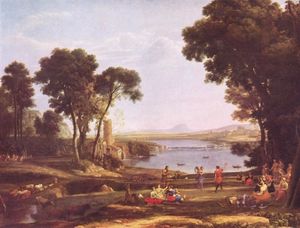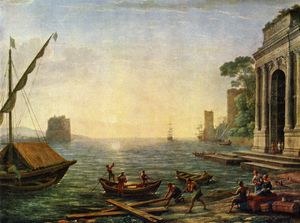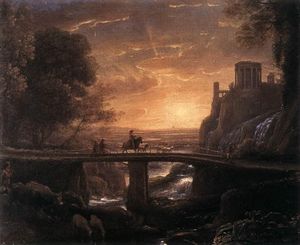Claude Lorrain Style and Technique
- Full Name:
- Claude Lorrain
- Short Name:
- Lorrain
- Alternative Names:
- Claude Gellée, dit le Lorrain
- Date of Birth:
- circa 1605
- Date of Death:
- 23 Nov 1682
- Focus:
- Paintings, Drawings
- Mediums:
- Oil, Wood, Other
- Subjects:
- Landscapes
- Art Movement:
- Baroque
- Hometown:
- Chamagne, France
- Claude Lorrain Style and Technique Page's Content
- Introduction
- Style
- Method
Introduction
Just like Poussin's paintings, Claude's style represents the classicizing strain of the Baroque, as opposed to the dynamic sensuality of artists like Rubens or Bernini. Claude is the emblematic figure of the classicizing ideal landscape, a genre whose roots are in the Venetian Renaissance, but which was pioneered in the 17th century by artists like Annibale Carracci and Domenichino.
Claude's idealized, heroic landscapes were incredibly influential; artists would continue to paint in Claude's style for generations to come. Claude's style can be described as "idealized realism"; although his paintings are grounded in naturalism, they are a perfected version of nature; his paintings show nature not as it is, but as it should be.
Claude Lorrain Style
To the casual observer, Claude's paintings may seem more or less the same throughout the entirety of his career. A closer look, however, reveals that there is a real evolution of style in the French Baroque painter's works.
Claude's early style bears witness to a strong Northern influence, an influence which would dissipate with time. Claude's early paintings are also lighter, brighter and livelier in style than his more mature works.
The paintings from this period are characterized by the following qualities;
• Lively dynamism
• Close attention to detail; details hidden away in the painting
• Strong naturalism
• Overwhelming importance of light; almost all paintings are images either of dawn or twilight (this continues throughout Claude's entire career)
• Picturesque charm
Mature Style:
In the 1640s, Claude's style began to evolve. The artist started to paint larger, more complex compositions for fewer patrons. The paintings from the 40s onwards also evidence an increasingly Italianate, classical influence, as opposed to the northern influence of the earlier paintings. Light becomes clearer in Claude's paintings from this period, and space becomes deeper and more carefully defined. Such works are characterized by the following qualities;
• More restrained palette, with an emphasis on blue, green and gray
• Style becomes more ideal
• Compositions become more Italianate, classical in style
• Light is clearer
• In the last paintings, there is often a so-called "otherworldly" quality, created by a loose treatment of space and melancholy, wistful tone
Claude Lorrain Method
Preparatory methods:
The uncanny beauty of Claude's paintings is due largely to his exacting and virtuoso technique. The naturalism of Claude's style, especially during his early period, has its roots in close study from nature.
These abundant landscape drawings not only give a fascinating glimpse into the artist's working methods, but are also beautiful works of art in their own right. Claude's preparation for his final canvases includes the following steps;
Claude spent his days roaming the Roman countryside, sketching prodigiously
Claude would then mix his palette on the spot and rush back to the studio
The artist would sometimes execute oil sketches while in the fields
Painting methods:
When executing the final painting, Lorrain employed the standard technique of first painting a white ground on the canvas, and then adding a second ground applied in layers of various thickness and various hues which would in turn influence the appearance of the final layers of paint.
The painter is famous for his brilliant blues, which were achieved by using ultramarine, the most expensive kind of pigment available (it was made from lapus lazali, a rare precious stone); few 17th century artists could afford to use this pigment to the extent that Claude did.
Finally, the artist would paint incredibly thin layers of paint over the prepared canvas, constantly varying his hues, shades and handling, thus creating an incredibly intricate and luminous pictorial surface. Unfortunately, the delicacy of Claude's technique was such that his paintings were easily damaged, and many have experienced chemical deterioration (a state known as blanching); thus, very few of this artist's paintings are still in their original condition.

